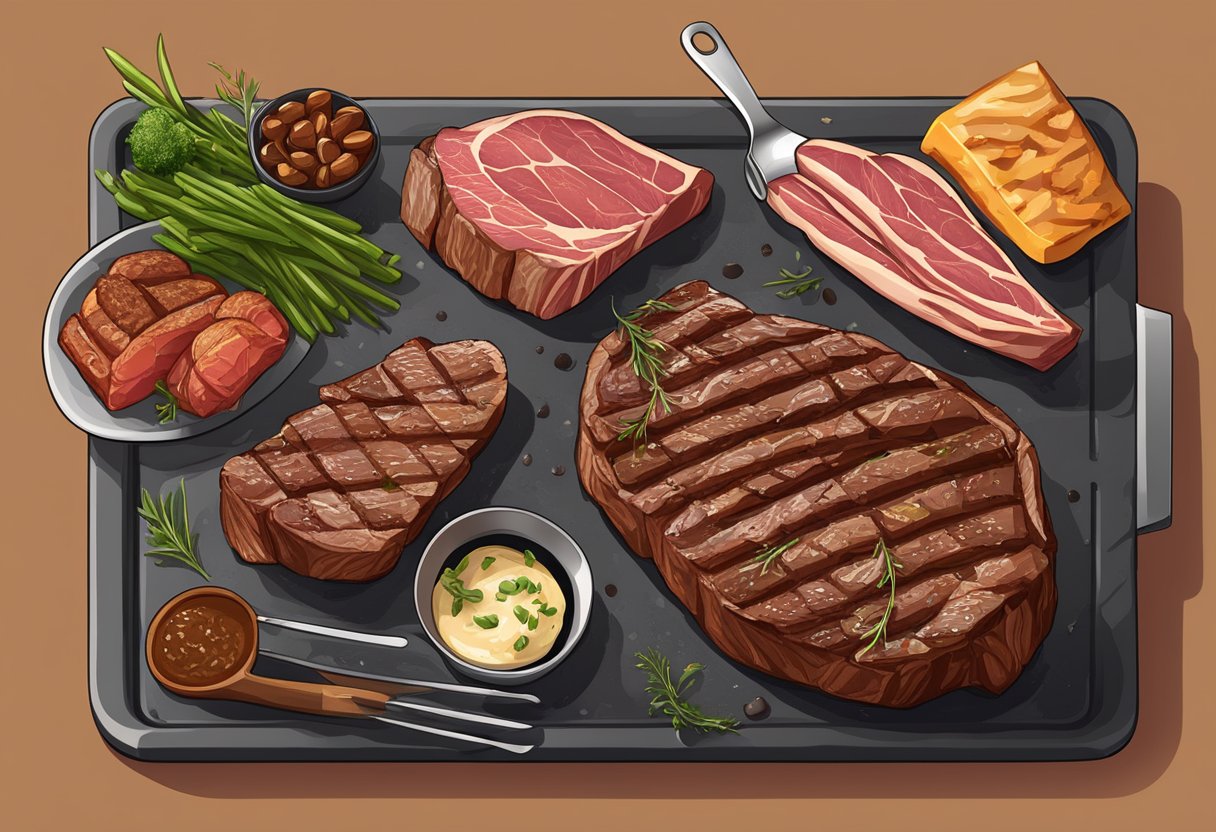Types Of Cooked Steak
Steak is a popular dish that can be cooked in various ways to suit different preferences. There are many types of steak, each with its unique flavor, texture, and tenderness. Understanding the different types of steak and how to cook them can help you achieve the perfect steak every time.
One of the most crucial factors to consider when cooking steak is the cut of meat. Different cuts of steak have different levels of tenderness and flavor. Knowing the different steak cuts can help you choose the right one for your recipe and cooking method.
Another essential factor to consider when cooking steak is the level of doneness. The level of doneness refers to how well-cooked the steak is and can affect the texture, flavor, and safety of the meat. There are several steak doneness levels, ranging from rare to well-done, and each has its benefits and risks.
Key Takeaways
- Understanding the different types of steak cuts and how to cook them is crucial for achieving the perfect steak.
- The level of doneness is an essential factor to consider when cooking steak, and it can affect the texture, flavor, and safety of the meat.
- Cooking techniques, enhancing steak flavors, and post-cooking tips can also impact the quality of the steak.
Understanding Steak Cuts

Selecting the Right Cut
When it comes to steak, selecting the right cut is crucial. The cut of meat determines the texture, flavor, and cooking method of the steak. A good butcher can help you choose the right cut of meat based on your preferences and cooking style.
One factor to consider when selecting a steak cut is marbling. Marbling refers to the amount of fat that is dispersed throughout the meat. More marbling typically results in a more flavorful and tender steak. However, some people prefer leaner cuts of meat.
Another factor to consider is whether the steak is bone-in or boneless. Bone-in steaks tend to have more flavor and are often considered more traditional, while boneless steaks are easier to eat and cook more quickly.
Steak Cut Varieties
There are many different types of steak cuts, each with their own unique characteristics. Here are a few of the most popular:
- Sirloin: This cut comes from the rear of the cow and is known for its lean meat and bold flavor. It can be bone-in or boneless and is often grilled or broiled.
- Tenderloin: This cut comes from the cow’s loin and is known for its tenderness. It is often considered the most luxurious cut of steak and is typically served as filet mignon.
- Ribeye: This cut comes from the cow’s rib section and is known for its marbling and rich flavor. It can be bone-in or boneless and is often grilled or pan-seared.
- Flank steak: This cut comes from the cow’s belly and is known for its lean meat and strong flavor. It is often marinated and grilled or broiled.
- Hanger steak: This cut comes from the cow’s diaphragm and is known for its tenderness and rich flavor. It is often marinated and grilled or broiled.
- Flat iron: This cut comes from the cow’s shoulder and is known for its tenderness and bold flavor. It is often grilled or pan-seared.
- Tri-tip: This cut comes from the cow’s bottom sirloin and is known for its lean meat and mild flavor. It is often grilled or roasted.
- Cube steak: This cut comes from the round (or back end) of the cow and is known for its tenderness. It is often pounded thin and used in dishes like chicken-fried steak.
By understanding the different steak cuts and their characteristics, you can choose the right cut for your preferences and cooking style.
Steak Doneness Levels
Steak doneness refers to the level of cooking of a steak. It is determined by the internal temperature of the steak and the amount of time it has been cooked. Different people have different preferences when it comes to steak doneness, which is why it is important to understand the different levels of doneness.
Rare and Medium-Rare
Rare steak is cooked for a short time, resulting in a cool, red center. It has an internal temperature of 120-130°F. Medium-rare steak is cooked slightly longer than rare steak, but still has a cool, red center. It has an internal temperature of 130-135°F.
Rare and medium-rare steak is preferred by those who want to taste the natural juices and flavor of the meat. The juices are still present in the steak, making it tender and juicy. The color of the steak is red, with a slight brown crust on the outside.
Medium and Medium-Well
Medium steak is cooked for a longer time than medium-rare steak. It has an internal temperature of 135-145°F. The center of the steak is pink, with a slightly brown crust on the outside. Medium-well steak is cooked even longer than medium steak, resulting in a slightly pink center with little to no juices. It has an internal temperature of 145-155°F.
Medium and medium-well steak is preferred by those who want a balance between the natural juices and the flavor of the meat. The color of the steak is pink, with a brown crust on the outside.
Well-Done
Well-done steak is cooked for a long time, resulting in a brown, dry center. It has an internal temperature of 160°F or higher. Well-done steak is preferred by those who want the meat to be fully cooked and have no pink or juices. The color of the steak is brown, with a dark crust on the outside.
In conclusion, steak doneness levels are important to understand in order to cook the perfect steak according to personal preference. The internal temperature of the steak is the key factor in determining the level of doneness. Whether you prefer rare, medium-rare, medium, medium-well, or well-done steak is a matter of personal taste.
Cooking Techniques
When it comes to cooking steak, there are several techniques to choose from. Each technique has its own advantages and disadvantages, and it’s up to the cook to decide which one to use based on their preferences and the cut of steak they are using.
Grilling Steaks
Grilling is a popular method of cooking steak, especially during the summer months. To grill a steak, preheat the grill to a high temperature and brush the steak with oil. Season the steak with salt and pepper or a dry rub, and place it on the grill. Cook the steak for a few minutes on each side, depending on the thickness of the steak and the desired level of doneness. Use a meat thermometer to check the internal temperature of the steak. Once the steak is cooked, let it rest for a few minutes before serving.
Pan-Searing
Pan-searing is another popular method of cooking steak, especially for thicker cuts. To pan-sear a steak, heat a skillet over high heat and add oil. Season the steak with salt and pepper or a dry rub, and place it in the skillet. Cook the steak for a few minutes on each side, depending on the thickness of the steak and the desired level of doneness. Use a meat thermometer to check the internal temperature of the steak. Once the steak is cooked, let it rest for a few minutes before serving.
Broiling
Broiling is a quick and easy method of cooking steak, especially for thinner cuts. To broil a steak, preheat the broiler to a high temperature and place the steak on a broiler pan. Season the steak with salt and pepper or a dry rub, and place it under the broiler. Cook the steak for a few minutes on each side, depending on the thickness of the steak and the desired level of doneness. Use a meat thermometer to check the internal temperature of the steak. Once the steak is cooked, let it rest for a few minutes before serving.
Overall, the key to cooking a great steak is to use high heat, season it well, and let it rest before serving. Whether you prefer grilling, pan-searing, or broiling, there are many ways to cook a delicious steak that will satisfy your taste buds.
Enhancing Steak Flavors
When it comes to steak, flavor is king. There are many ways to enhance the flavor of cooked steak, from marinades and rubs to butter and sauces. In this section, we’ll explore some of the most popular methods for enhancing steak flavors.
Marinades and Rubs
Marinades and rubs are a great way to add flavor to steak. Marinades are typically made with acidic ingredients like vinegar or citrus juice, which help to tenderize the meat and infuse it with flavor. Rubs, on the other hand, are a dry mixture of herbs and spices that are rubbed onto the surface of the meat before cooking.
For a simple marinade, try mixing together olive oil, balsamic vinegar, garlic, salt, and pepper. For a rub, try mixing together paprika, garlic powder, onion powder, salt, and black pepper.
When marinating or using a rub, be sure to let the steak sit for at least an hour (or up to 24 hours) to allow the flavors to penetrate the meat. You can also brush the steak with the marinade or rub while cooking for an extra burst of flavor.
Butter and Sauces
Butter and sauces are another great way to add flavor to steak. A pat of butter on top of a hot steak can add richness and depth of flavor, while a sauce can provide a burst of flavor that complements the meat.
For a simple garlic butter, melt butter in a pan and add minced garlic and a pinch of salt. Cook for a minute or two until the garlic is fragrant, then pour over the steak.
For a sauce, try making a red wine reduction by cooking red wine, beef broth, and shallots together until the liquid has reduced by half. Strain out the solids and pour the sauce over the steak.
No matter which method you choose, be sure to let the steak rest for a few minutes after cooking to allow the juices to redistribute. This will help to ensure that the steak is juicy and flavorful.
Post-Cooking Tips
Resting the Steak
After cooking, it is important to let the steak rest for a few minutes before slicing and serving. This allows the juices to redistribute throughout the meat, resulting in a more tender and juicy steak. The recommended resting time varies depending on the thickness of the steak, but a general rule of thumb is to rest the steak for at least 5 minutes.
During the resting period, the steak will continue to cook slightly, so it is important to take this into account when determining the desired level of doneness. Additionally, it is recommended to tent the steak with foil during the resting period to keep it warm and prevent it from drying out.
Slicing and Serving
When slicing the steak, it is important to cut against the grain to ensure maximum tenderness. The grain refers to the direction of the muscle fibers in the meat. Cutting against the grain breaks up the connective tissue and makes the steak easier to chew.
It is also important to plate the steak properly. A common technique is to place the steak on a warm plate to prevent it from cooling too quickly. Additionally, adding a pat of butter or a drizzle of olive oil on top of the steak can add flavor and moisture.
Leftover steak can be stored in the fridge for up to 3-4 days. To reheat, it is recommended to use a low heat setting to prevent overcooking and drying out the steak. To maintain the crust of the steak, it is recommended to reheat in a pan rather than in the microwave.
By following these post-cooking tips, one can ensure a delicious and tender steak every time.






